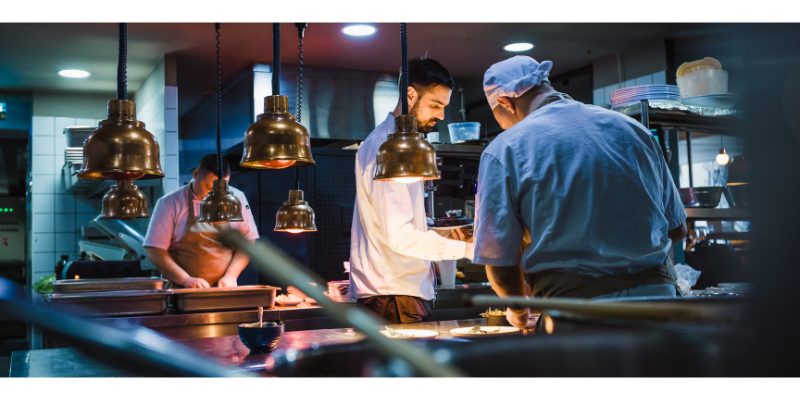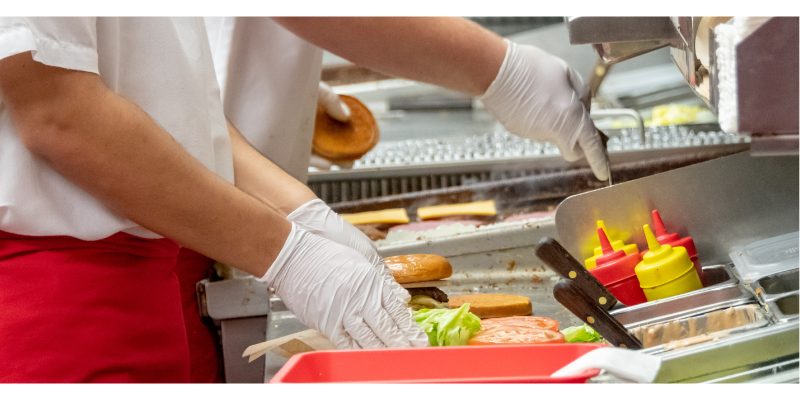Let’s delve into the restaurant industry projections for 2024 and explore what’s cooking in the world of dining experiences.
As we step into the future of the restaurant industry, it’s crucial to anticipate the changes and trends that will shape the dining landscape in 2024.
From embracing digital innovations to understanding the evolving preferences of consumers, restaurant owners must stay ahead of the curve to thrive in this competitive market.
Embracing the Digital Revolution in Dining Experiences

The landscape of the dining experience is undergoing a significant transformation, propelled by the unstoppable momentum of digital innovation.
As we navigate through the third quarter into 2024, the integration of technology within the restaurant industry projections emerges as a non-negotiable facet of modern dining.
For restaurants seeking to distinguish themselves in a crowded marketplace, the adoption of digital tools is not merely an option but a strategic necessity.
The forefront of this revolution sees mobile ordering systems and contactless payment methods enhancing operational efficiency while simultaneously catering to the growing consumer demand for convenience and speed.
But the digital embrace extends beyond mere transactional interactions.
Personalized marketing efforts, powered by sophisticated data analytics, are enabling establishments to connect with diners on a new level, offering tailored experiences that resonate on a personal note.
In an era where digital presence equates to relevance, the successful restaurant of 2024 will leverage these technologies to create a seamless bridge between the kitchen and the consumer.
It’s a move that not only streamlines operations but also enriches the dining experience, making every interaction count.
In this dynamic, technology-infused landscape, restaurants have the unique opportunity to redefine hospitality, making every meal an occasion and every guest a priority.
Restaurant Industry Projections: The Rise of Sustainability and Ethical Eating
As the calendar turns to the second half of 2024, the momentum toward sustainability and ethical consumption in the restaurant industry accelerates, reflecting a deep-seated shift in societal values.
This evolving landscape commands a pivot towards practices that not only preserve the planet but also respect the intricate web of life that sustains it.
The modern diner increasingly seeks out establishments that are not merely places to eat but are bastions of environmental stewardship and ethical responsibility.
In response, savvy restaurant owners are integrating sustainability into the core of their business models, recognizing that the path to a customer’s heart is increasingly through their values.
This includes initiatives such as partnering with local farmers to shorten supply chains and championing seasonal menus that reduce carbon footprints.
Moreover, efforts to minimize waste, from food to packaging, are not just seen as cost-saving measures but as moral imperatives that resonate with a growing cohort of environmentally conscious consumers.
The journey towards ethical eating also encompasses a broader understanding of food sourcing, with a spotlight on humane animal husbandry and fair-trade practices.
By aligning with these principles, restaurants not only cater to the ethical considerations of their patrons but also contribute to a larger trend and narrative of global sustainability and ethical integrity.
This paradigm shift underscores a profound transformation in the restaurant industry, where success in 2024 hinges on the harmonious blend of culinary excellence and ethical conviction.
Understanding the 2024 Consumer: Preferences and Expectations
The 2024 consumer palette is an intricate mosaic of tastes, shaped by an ever-broadening exposure to global cuisines and a deepened commitment to health and sustainability.
This year, restaurant-goers arrive with a set of expectations that reflect not only a hunger for innovative and diverse flavors but also an insistence on ethical sourcing and environmental responsibility.
To meet these demands, restaurants are tasked with a delicate balancing act: curating menus that are at once eclectic and familiar, adventurous yet grounded in the principles of sustainability.
The rise of plant-based dining continues unabated, driven by a combination of health consciousness and ethical concerns.
Meanwhile, the appetite for global flavors invites chefs to explore authentic and fusion dishes, promising a culinary journey that spans continents from the comfort of a dining table.
Yet, amid this enthusiasm for diversity, simplicity and authenticity remain paramount.
The 2024 diner values transparency in ingredient sourcing and preparation, seeking assurance that their food choices align with their environmental and ethical standards.
To captivate this sophisticated audience, restaurants must weave these diverse threads into a coherent and compelling dining narrative.
By doing so, they not only satiate the appetite but also speak to the values and aspirations of their guests, ensuring a dining experience that resonates deeply and endures in memory.

The Impact of Economic Trends on Restaurant Costs
Navigating the ebbs and flows of economic trends presents a critical challenge for the restaurant industry projections as we look into 2024.
With the global economy in a state of flux, restaurant owners find themselves at the mercy of variable ingredient pricing and labor costs, elements foundational to their operational framework.
These economic variances necessitate a strategic finesse in menu pricing and cost management, propelling restaurant owners toward innovative solutions that safeguard profitability without compromising on quality.
The specter of inflation looms large, exerting pressure on both restaurant equipment and supplies costs and wage expectations, while market dynamics dictate the availability and cost-effectiveness of ingredients.
To counteract these pressures, savvy restaurateurs are exploring alternative procurement strategies, such as establishing direct relationships with restaurant supplies and equipment dealers, restaurant smallware suppliers, and local producers or embracing seasonal menus to leverage cost-efficient, locally-sourced produce.
Simultaneously, optimizing kitchen operations through technology and process refinement offers a pathway to reducing waste and maximizing restaurant efficiency, thereby buffering the impact of economic uncertainties.
Embracing these strategies requires a keen understanding of the broader economic landscape and its implications for the restaurant sector.
By staying informed and adaptable, restaurant owners can navigate the complexities of economic trends, ensuring their establishments remain resilient in the face of fluctuating costs and maintain the exquisite dining experiences their patrons expect.
Innovative Solutions to Supply Chain Challenges
In the dynamic culinary world of 2024, addressing supply chain challenges with innovation is not just beneficial—it’s imperative for the forward-thinking restaurant.
The landscape demands agility and strategic partnerships that underscore reliability and sustainability in equal measure.
Enter the era of technological prowess, where sophisticated inventory management systems and predictive analytics become the backbone of operational resilience.
These tools offer a crystal-clear insight into supply needs and potential bottlenecks, allowing for proactive adjustments that keep the kitchen running smoothly without interruption.
Furthermore, the cultivation of direct relationships with local producers is more than a trend; it’s a strategic maneuver that not only ensures a steady flow of high-quality ingredients but also fortifies the restaurant’s commitment to community and sustainability.
This approach not only mitigates the risks associated with global supply chain disruptions but also enhances the narrative of each dish served, connecting diners more deeply to their food’s journey from farm to fork.
By weaving these innovative strategies into the fabric of their operations, restaurants can navigate the complexities of supply chain management with grace, ensuring that every plate they serve reflects both the quality and the resilience of their brand.
The Evolution of Dining Spaces and Restaurant Design
The ambiance and physical layout of dining venues are undergoing an elegant transformation as we approach the third and fourth quarter of 2024, signaling a renaissance in how restaurateurs conceive and execute the design of their spaces.
The aesthetics of a restaurant, far beyond mere functionality, now play a pivotal role in shaping the dining experience, mirroring the sophistication and individuality of the cuisine offered.
This evolving design ethos reflects a blend of innovation and intimacy, where architectural creativity meets the comfort and expectations of the modern diner.
Forward-thinking restaurant owners are investing in spaces that speak to the narrative of their brand and the stories behind their menus.
From incorporating elements of nature with indoor greenery and natural lighting to integrating cutting-edge digital art displays, the aim is to craft environments that stimulate the senses and foster a unique connection with guests.
This approach goes hand in hand with a move towards more adaptable layouts, accommodating diverse dining experiences ranging from private celebrations to casual, communal eating.
As design trends veer towards sustainability and minimalism, the choice of materials and construction techniques also becomes a statement of a restaurant’s commitment to environmental responsibility.
Innovative use of recycled materials, energy-efficient lighting, and waste-reducing designs are not just ethically appealing but also resonate deeply with a clientele increasingly concerned with the planet’s well-being.
In essence, the evolution of dining spaces into 2024 is a testament to the industry’s ability to blend aesthetic allure with ethical practice, creating spaces that are not only visually captivating but also emblematic of a broader societal shift towards sustainability and mindful consumption.
Mastering the Art of Marketing in the Digital Age
The digital age unfolds a panorama of marketing opportunities for those poised to captivate and engage a discerning clientele.
In the bustling world of 2024, the restaurant industry’s pulse quickens, driven by the rapid exchange of online interactions and digital footprints.
As such, adeptness in digital marketing becomes not merely an advantage but a cornerstone of brand visibility and customer connection.
Tailored email campaigns, Google reviews for restaurants, vibrant social media content, and strategic SEO practices now serve as the lifeblood of market engagement, propelling restaurants into the spotlight of their targeted audience.
Influencer partnerships, with their authentic reach and audience trust, emerge as potent tools in shaping culinary trends and dining preferences.
Meanwhile, the power of storytelling, shared through blogs, videos, and online reviews, crafts a compelling narrative around a restaurant’s ethos and offerings.
This multifaceted digital approach allows for a nuanced understanding of customer desires, ensuring that every promotional effort is an invitation to an unparalleled dining experience.
In mastering these elements, restaurants set the stage for a thriving presence in the digital marketplace, inviting diners into a world where every meal tells a story.

Leveraging Data Analytics for Strategic Decision-Making
In the vibrant landscape of 2024, where the pulse of the restaurant industry projections beats in tandem with the rhythm of technological advancement, data analytics emerges as a beacon of strategic illumination.
This powerful tool offers restaurant owners the unprecedented ability to peel back the layers of customer preferences, uncovering patterns and trends that were once obscured by the complexity of daily operations.
By harnessing the rich insights provided by data analytics, restaurateurs can refine their menus with precision, tailoring offerings to meet the ever-evolving desires of their clientele with unmatched accuracy.
This data-driven approach transcends traditional guesswork, empowering decision-makers to allocate resources more efficiently, streamline service delivery, and ultimately, craft experiences that resonate deeply with diners.
In this era of information, leveraging data analytics is not just about navigating the currents of change—it’s about setting a course for success in the bustling world of 2024.
Navigating Regulatory Changes and Compliance
In the evolving landscape of 2024, adept navigation through regulatory changes and compliance emerges as a cornerstone of restaurant operations.
The complexity of this terrain, marked by an ever-shifting mosaic of food safety standards, labor regulations, and environmental mandates, demands vigilance and adaptability.
Restaurants are called to stay informed, with a keen eye on legislative updates that impact the industry, ensuring that every aspect of their operation aligns with the latest requirements.
Proactive engagement with these legal frameworks not only safeguards against potential liabilities but also reinforces a restaurant’s commitment to excellence and trustworthiness.
By embedding compliance into the DNA of their business strategies, owners can focus on crafting exceptional dining experiences, secure in the knowledge that their establishments stand on solid regulatory ground.
This dedication to staying ahead of the curve in regulatory matters is what sets a restaurant apart in the dynamic world of 2024, embodying a blend of responsibility, innovation, and leadership.
The Importance of Building a Resilient Business Model
Crafting a resilient business model stands at the heart of thriving in the tumultuous landscape of the restaurant industry projections as we embrace 2024.
This pivotal approach encompasses a commitment to flexibility, allowing for swift adaptation to the ebbs and flows of market dynamics and consumer trends.
It signifies the art of foreseeing challenges and sculpting strategies that ensure sustainability and growth amidst uncertainties.
By embedding innovation into their operational DNA, restaurant owners lay a solid foundation for not just surviving but flourishing, carving paths through the competitive terrain with agility and strategic foresight.
This resilience is the beacon guiding restaurants towards enduring success in a rapidly evolving marketplace.